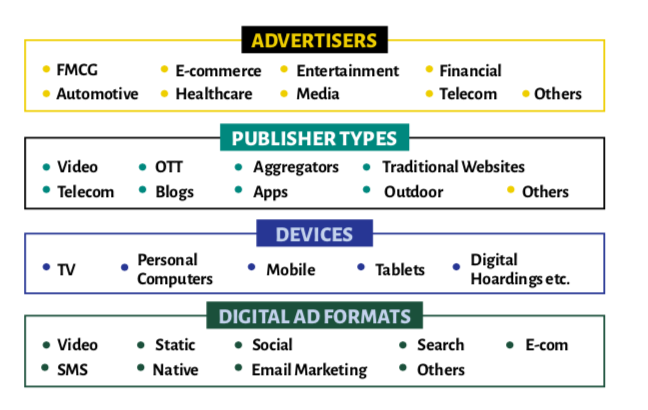A sneak peek into how adtech platforms are setting the tone for digital media’s maturity in the Indian landscape

18 August, 2022
The dynamism of the advertising landscape only gets more complex with ever-increasing platforms available for advertising combined with upgraded technology that allows for the creation of newer advertising mediums. The advertising ecosystem can be explained with the following stakeholders and components:

At the center of all this are the AdTech platforms that play an important role in bringing together the advertising ecosystem with a deep understanding of how and where to activate audiences, along with creating an infrastructure to be able to deliver.
AdTech remains a critical part of the digital advertising ecosystem that facilitates buying, delivering and measuring digital advertising. AdTech consists of all technology including, but not limited to, software used to deliver to audiences, as well as the ability to measure the performance of these campaigns.
AdTech innovation and its current form continue to simplify the complex web of buying and selling advertising. There are several ad-tech tools and platforms such as Demand-side platforms, ad networks, publisher management platforms, etc., which facilitate buying inventory across publishers and effectively reach an advertiser's targeted audiences. The platforms allow the advertisers/agencies to plan effectively and efficiently manage their campaign budgets to maximise their Return-on-Investment (ROI).
A few of the key components of the ad-tech landscape:
-Demand-side platforms: A demand-side platform (DSP) is where advertisers can buy all forms of inventory from display to video ads. DSPs connect all components of the advertising ecosystem by allowing advertisers to activate audiences through direct integration, supply-side platforms and ad exchanges. There are several benefits of working with DSPs because of the flexibility and automation it provides. Advertisers can make changes to the campaign in-flight, instead of waiting to measure performance at the end of the campaign
-Supply-side platforms: A supply side-platform (SSP) is where publishers host their available inventory. SSPs let publishers maximise their ad inventory slots. Interestingly, what initially started as a platform to sell unsold inventory, has now become a mechanism to programmatically activate and optimise all inventory
-Ad-networks: Ad networks work as intermediaries between publishers and advertisers. Ad networks typically aggregate all inventory from all supply-side sources and then match them to advertisers and agencies' demand
-Agency trading desk: Agency trading desk (ATD) tools are used for media planning and media buying and are run by media agencies. Over the years, ATD tools have evolved to optimise for programmatic advertising campaigns

What sets a superior AdTech platform apart from the rest?
AdTech continues to simplify the sophisticated digital buying, managing and selling platforms. A powerful ad-tech provider delivers ROI by ensuring
*The author is Gulshan Verma, CEO, JioAds
Disclaimer: The views expressed in the article above are those of the authors' and do not necessarily represent or reflect the views of this publishing house. Unless otherwise noted, the author is writing in his/her personal capacity. They are not intended and should not be thought to represent official ideas, attitudes, or policies of any agency or institution.
Your e-mail information will not be shared with anyone else. And it will be used only to send out our latest news.

BW Communities is an array of business news websites targeted towards niche communities and readers across various industries



